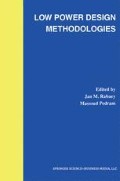Abstract
With energy-recovery CMOS, circuit energy that would otherwise be dissipated as heat is instead conserved for later reuse. From such an approach to low power, there are no a priori limits to the degree to which energy and power dissipation can be reduced inside a circuit. By externally controlling the length and shape of the signal transitions, the energy expended to transition a signal between logic levels can be reduced to an arbitrarily small degree. In contrast, unconventional digital CMOS circuits, the energy dissipated to “flip a bit” from one to zero or vice versa is a fixed and non-negotiable quantity on the order of (1/2) CV 2 Methods and techniques to reduce dissipation are thus limited to minimizing the number of transitions required to carry out a computation, or reducing the magnitude of the individual capacitances (C) or the voltage swing (V) between logic levels zero and one. These methods offer significant energy and power reduction but they are ultimately limited by (1/2) CV 2.
Access this chapter
Tax calculation will be finalised at checkout
Purchases are for personal use only
Preview
Unable to display preview. Download preview PDF.
References
G. M. Amdahl, “Validity of Single-processor Approach to Achieving Large-scale Computing Capability”Proc. AFIPSConference, pp. 483–485, Reston VA., 1967.
W.C. Athas, J.G. Koller, L. Svensson, “An Energy-Efficient CMOS Line Driver Using Adiabatic Switching,” Fourth Great Lakes Symposium on VLSI, Mar. 1994.
W.C. Athas, L. Svensson, J.G. Koller, N. Tzartzanis, E. Chou, “A Framework for Practical Low-Power Digital CMOS Systems Using Adiabatic-Switching Principles,” 1994 International Workshop on Low Power Design, Apr. 1994.
W.C. Athas, L. Svensson, “Reversible Logic Issues in Adiabatic CMOS,” Proc. of the 1994 Workshop on Physics and Computation, Nov. 1994.
W.C. Athas, L. Svensson, J.G. Koller, N. Tzartzanis, E.Y.-C Chou, “Low-Power Digital Systems Based on Adiabatic-Switching Principles,” IEEE Trans. on VLSI Systems, Vol. 2, No. 4, Dec. 1994.
W.C. Athas, “Low Power Design Methodologies,” Kluwer Academic Press, 1995.
J.D. Bunda, “Instruction-Processing Optimizations Techniques for VLSI Microprocessors,” Ph.D. thesis, Univ. of Texas at Austin, May, 1993.
J.B Burr, A.M. Petersen, “Energy Considerations in Multichip-Module based Multiprocessors,”IEEE International Conference on Computer Design1991.
A.P. Chandrakasan, S. Sheng, R.W. Brodersen. “Low-Power CMOS Digital Design,”IEEE JSSCvol. 27, no. 4, pp. 473–484, Apr. 1992.
J.S. Denker, “A Review of Adiabatic Computing,”1994 IEEE Symposium on Low Power ElectronicsOct. 1994.
D.J. Frank, P. Solomon, “Electroid-Oriented Adiabatic Switching Circuits,”1995 Int’l Symposium on Low-Power DesignApr. 1995.
L.A. Glasser, D.W. Dobberpuhl, “The Design and Analysis of VLSI Circuits,” Addison-Wesley, Reading, 1985.
J.S. Hall, “An Electroid Switching Model of Reversible Computer Architectures,” Proc. ICCI `92, Fourth International Conf. on Computing and Information, 1992.
R.E. Joynson, J.L. Mundy, J.F. Burgess, C. Neugebauer, “Eliminating Threshold Losses in MOS Circuits by Bootstrapping Using Varactor Coupling,”IEEE Jnl. of Solid-State CircuitsSC-7,No. 3, June 1972.
J.G. Koller, W.C. Athas, “Adiabatic Switching, Low Energy Computing, and the Physics of Storing and Erasing Information,” Proc. of the 1991 Workshop on Physics and Computation, Nov. 1991.
R. Landauer, “Irreversibility and Heat Generation in the Computing Process,”IBM Journal, July 1961.
D. Maksimovic. “A MOS Gate Drive with Resonant Transitions,” Proc. IEEE Power Electronics Specialists Conference, IEEE Press, 1991.
C.A. Mead, L. Conway, “Introduction to VLSI Systems,” Addison-Wesley, Reading, 1980.
C.L. Seitz, A.H. Frey, S. Mattisson, S.D. Rabin, D.A. Speck, J.L.A. van de Snepscheut, “Hot-Clock nMOS,” Proc.of the 1985 Chapel-Hill Conf. on VLSI, Apr. 1985.
M. Shichman, D.A. Hodges, “Modeling and simulation of insulated-gate field-effect transistor switching circuits,” IEEE Jnl. of Solid-State Circuits, SC-3, 285, Sept. 1968.
L. Svensson, “Logic Style for Adiabatic Circuits,” ISI Internal Report, Mar. 1994.
L. Svensson, J.G. Koller “Driving a Capacitive Load without Dissipating fCV2” 1994 IEEE Symposium on Low Power Electronics, Oct. 1994.
N. Tzartzanis, W.C. Athas, “Design and Analysis of a Low Power Energy-Recovery Adder,” Fifth Great Lakes Symposium on VLSI, Mar. 1995.
N.H.E. Weste, K. Eshraghian, “Principles of CMOS VLSI Design: A Systems Perspective,” Addison-Wesley Publishing Company, 1994.
S.G. Younis, T.F. Knight, “Practical Implementation of Charge Recovery Asymptotically Zero Power CMOS,” Proc. of the 1993 Sym. on Integrated Systems, MIT Press, Apr. 1993.
S.G. Younis, “Asymptotically Zero Energy Computing Using Split-Level Charge Recovery Logic,” Ph.D. thesis, Massachusetts Institute of Technology, June 1994.
S.G. Younis, T.F. Knight, “Switchless Non-Dissipative Rail Drivers for Adiabatic Circuits,” Proc. of the 1995 Chapel-Hill Conference on VLSI, Apr. 1995.
Editor information
Editors and Affiliations
Rights and permissions
Copyright information
© 1996 Springer Science+Business Media New York
About this chapter
Cite this chapter
Athas, W.C. (1996). Energy-Recovery CMOS. In: Rabaey, J.M., Pedram, M. (eds) Low Power Design Methodologies. The Springer International Series in Engineering and Computer Science, vol 336. Springer, Boston, MA. https://doi.org/10.1007/978-1-4615-2307-9_4
Download citation
DOI: https://doi.org/10.1007/978-1-4615-2307-9_4
Publisher Name: Springer, Boston, MA
Print ISBN: 978-1-4613-5975-3
Online ISBN: 978-1-4615-2307-9
eBook Packages: Springer Book Archive

